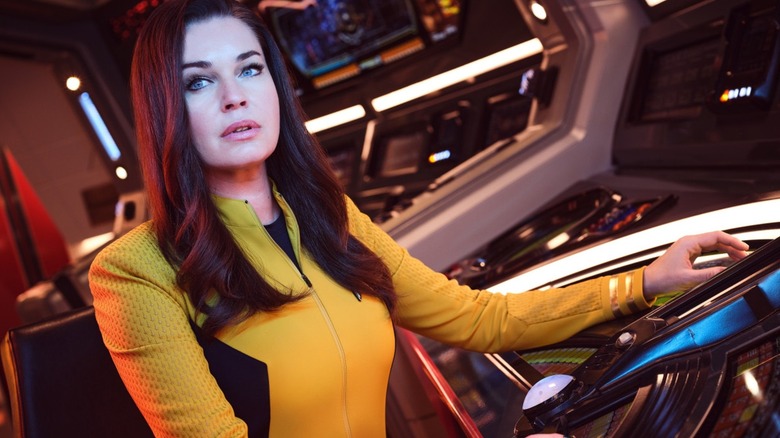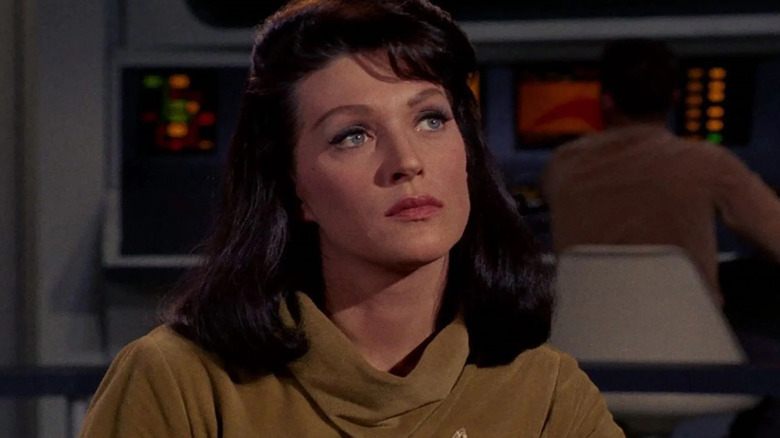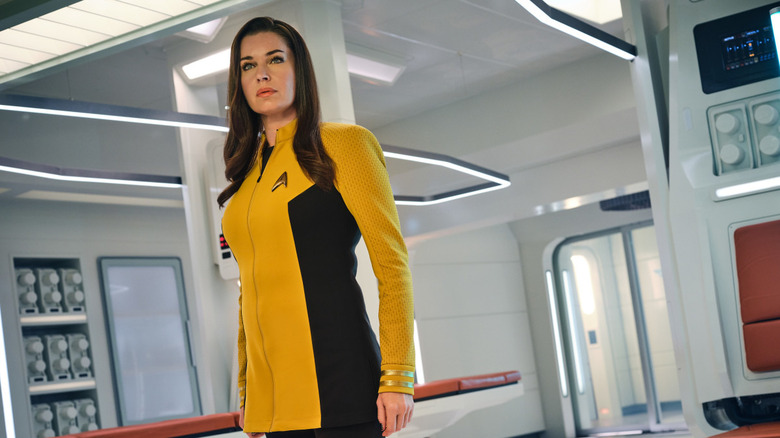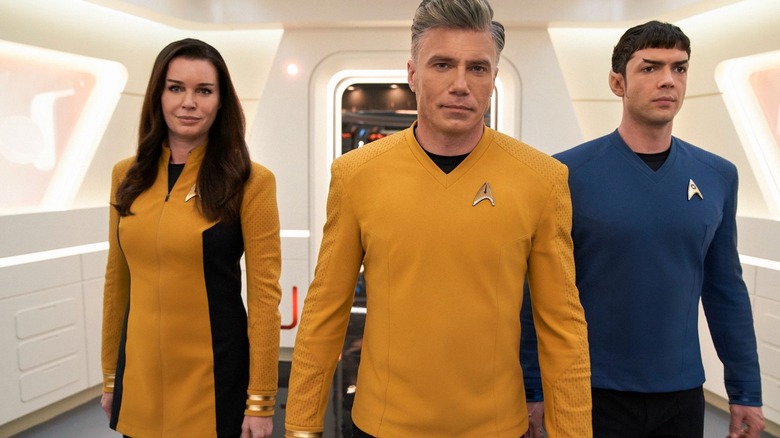Star Trek's Most Mysterious Character Now Has A Backstory
We may receive a commission on purchases made from links.
This post contains spoilers for episode 3 of "Star Trek: Strange New Worlds."
"Star Trek: Strange New Worlds" is, even more so than most of the recent "Trek" shows, a legacy program. While "Star Trek: Picard" steers into nostalgia like a raft caught in a current and "Star Trek: Lower Decks" is lousy with references to older "Trek" episodes, it's "Strange New Worlds" that features a cast made up almost entirely of "Trek" characters previously seen. Captain Pike (Anson Mount) was originally played by Jeffrey Hunter. Spock (Ethan Peck) was played by Leonard Nimoy. Nurse Chapel (Jess Bush) was played by Majel Barrett. Dr. M'Benga (Babs Olusanmokun) was originally played by Booker Bradshaw. Uhura (Celia Rose Gooding) was originally played by Nichelle Nichols. And while Khan (Ricardo Montalbán) is not on the show, his descendant La'an (Christina Chong) is. The only wholly new characters are the engineer Hemmer (Bruce Horak) and helm operator Erica Ortegas (Melissa Navia).
The most exciting legacy character on "Strange New Worlds," however, is certainly Una Chin-Riley (Rebecca Romijn), previously only known as Number One and originally played by Majel Barrett in the 1966 "Star Trek" pilot episode "The Cage."
Exciting, because "Strange New Worlds" will finally have an opportunity to explore a character that has remained notoriously mysterious for multiple decades of "Trek" history. In 1966, all audiences knew about Number One was that she was the first officer of the Enterprise, possessed a great deal of authority, and was going to have to stare sexism in the face on a regular basis (Pike has a notorious line of dialogue in "The Cage," saying that he can't get used to having a woman on the bridge). Thanks to the third episode of "Strange New Worlds," — "Ghosts of Illyria" — a lot of Number One's backstory is now filled in, and — playing fair — the "Trek" creators have redefined her, broadening her character into something few viewers could have predicted.
The original Number One
In "The Cage," Number One was little more than a professional authority figure. The pilot episode was so busy with its story of Pike, the Talosians' mental illusions, and trying to hook up the captain with a potential mating partner in a woman named Vina (Susan Oliver) that few other members of the ensemble were given a moment to shine. Number One is eventually kidnapped by the Talosians, along with a young yeoman (Laurel Goodwin), each one presented to Pike as potential mating partners when Pike refuses to procreate with Vina in front of the voyeuristic aliens (One might sense a small streak of prurient male fantasy running through Roddenberry's creation).
When Number One is trapped in the Cage with Pike, the Talosians describe her as having a superior mind. She's the one who is interested in computations and numbers. The Talosians also read her mind and say that, while she apparently lacks emotions, it's merely a pretense and that she frequently fantasizes about the captain. Her secret feelings for the captain are wisely — at least so far — being ignored by the makers of "Strange New Worlds."
It was posited in Daniel Leonard Bernardi's 1998 book "Star Trek and History: Race-ing Toward a White Future" that one of the reasons NBC rejected the original pilot, apart from it being "too cerebral," was the presence of a woman in authority. Additionally, NBC was upset that Roddenberry wanted Barrett in the role, an unknown actress that the studio knew Roddenberry was dating. For the second "Trek" pilot, the character was written out.
The Illyrians
In "Ghosts of Illyria," the newly christened Una Chin-Riley ("Una," I'm guessing, as a play on "Number One") takes command of the Enterprise in the middle of a health crisis: A mysterious virus is spreading among the crew, the primary symptom being their hypnotic attraction to bright lights. Una is able to fight off the virus (!) and goes about investigating the disease's spread. Pike and Spock, meanwhile, are stranded on the planet below, a place called Illyria. And no, while stranded in Illyria, neither of them disguises themselves as their dead fraternal twin sibling to infiltrate the court of Duke Orsino. (That's a "Twelfth Night" reference. Sorry.)
The planet of Illyria is a reference to the "Star Trek: Enterprise" episode "Damage" (first aired: April 21, 2004). In that episode, the Enterprise had been damaged in a dogfight with the Xindi in the previous episode, and were left with dead crew members and a broken warp coil. While adrift, the ship encounters an Illyrian vessel, also damaged by some gravitational razzmatazz in a forbidding area of space called the Delphic expanse. The Illyrians explain that they are genetically enhanced race that tinkers with their own genomes as a matter of course. By the end of the episode, Captain Archer (Scott Bakula) will attack the Illyrians and steal their warp coil. No one is happy about that. The Illyrians are left stranded. Archer never goes back to help them.
Una, the Illyrian
At the end of "Ghosts of Illyria," Commander Chin-Riley has to reveal a secret to the captain: She was able to fight off the disease because she is, in fact, an Illyrian herself. She lied about her species on her Starfleet application and has been posing as a human this whole time. Pike, being a laidback kind of captain, does not reprimand her, nor suggest disciplinary actions to his superiors. He simply rolls with it. Whether or not Number One will restore her cranial ridges — the Illyrians in "Damage" didn't look entirely human — remains to be seen.
In the mythology of "Star Trek," genetic engineering is strictly verboten, largely because of the much talked-out and devastating Eugenics Wars. Khan was a tyrant from said wars, and the conflict would lead to an outright ban on genetic manipulation for reasons of personal enhancement. La'an still bears the genes of her enhanced ancestor, and her status is well-known in Starfleet. Cin-Riley, knowing the law — and the taboo — against manipulation, opted to keep her identity secret. By episode three, the cat is out of the bag. Perhaps she was relieved when that Talosians didn't find that in her mind back in 1966.
Not only is Una now a far richer character with a more interesting backstory, but it seems that the "Trek" writers have played fairly. Because Number One was grievously underwritten in the 1960s, she's more or less a blank canvas. Presenting the character as a genetically enhanced Illyrian does not undo anything established. It merely confronts our assumptions. Additionally, La'an and Una now have something in common, and may find themselves bonding over their "outsider" status on the Enterprise.
Now, we find, there is much more to explore.



